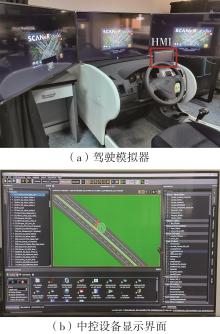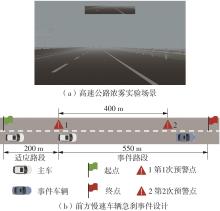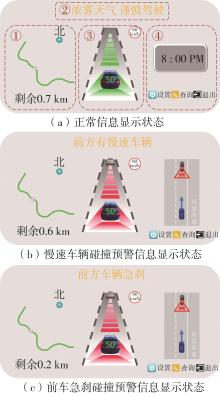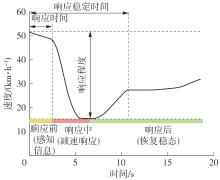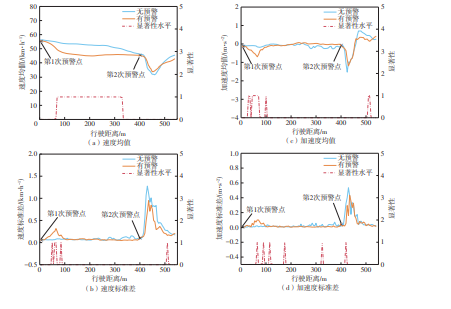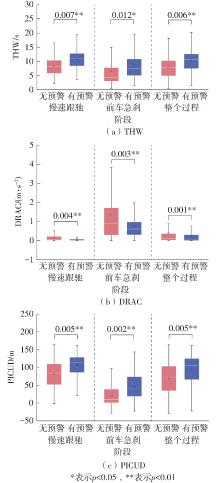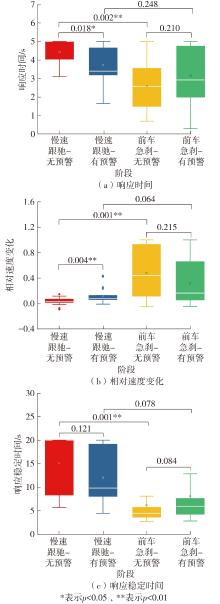Journal of South China University of Technology(Natural Science Edition) ›› 2025, Vol. 53 ›› Issue (2): 27-37.doi: 10.12141/j.issn.1000-565X.240122
• Traffic Safety • Previous Articles Next Articles
Impact of Connected Collision Warning Information System on Freeway Driving Behavior in Foggy Conditions
REN Wenhao, ZHAO Xiaohua, CHEN Chen, FU Qiang
- Beijing Key Laboratory of Traffic Engineering,Beijing University of Technology,Beijing 100124,China
-
Received:2024-03-13Online:2025-02-25Published:2025-02-03 -
Contact:陈晨(1992—),男,博士,讲师,主要从事自动驾驶安全评估、驾驶行为建模研究。 E-mail:chenchen@bjut.edu.cn -
About author:任文浩(1996—),男,博士生,主要从事网联自动驾驶研究。E-mail: renwenhao@emails.bjut.edu.cn -
Supported by:the National Natural Science Foundation of China(52072012)
CLC Number:
Cite this article
REN Wenhao, ZHAO Xiaohua, CHEN Chen, FU Qiang. Impact of Connected Collision Warning Information System on Freeway Driving Behavior in Foggy Conditions[J]. Journal of South China University of Technology(Natural Science Edition), 2025, 53(2): 27-37.
share this article
Table 2
Mean values of safety indicators and their significance analysis results"
| 指标 | 无预警信息均值 | 有预警信息均值 | 预警信息显著性 | ||||||
|---|---|---|---|---|---|---|---|---|---|
| 慢速跟驰 | 前车急刹 | 整个过程 | 慢速跟驰 | 前车急刹 | 整个过程 | 慢速跟驰 | 前车急刹 | 整个过程 | |
| THW/s | 8.36 | 6.65 | 8.01 | 10.80 | 8.59 | 10.33 | 0.007** | 0.012* | 0.006** |
| DRAC/(m·s -2) | 0.15 | 1.35 | 0.40 | 0.09 | 0.77 | 0.23 | 0.004** | 0.003** | 0.001** |
| PICUD/m | 81.49 | 20.22 | 68.79 | 107.00 | 46.41 | 94.10 | 0.005** | 0.002** | 0.005** |
Table 3
Mean values of driver compliance indicators and their significance analysis results"
| 指标 | 无预警信息均值 | 有预警信息均值 | 预警信息显著性 | 不同阶段显著性 | ||||
|---|---|---|---|---|---|---|---|---|
| 慢速跟驰 | 前车急刹 | 慢速跟驰 | 前车急刹 | 慢速跟驰 | 前车急刹 | 无预警 | 有预警 | |
| 响应时间/s | 4.43 | 2.59 | 3.72 | 3.15 | 0.018* | 0.210 | 0.002** | 0.248 |
| 相对速度变化 | 0.04 | 0.48 | 0.13 | 0.32 | 0.004** | 0.215 | 0.001** | 0.064 |
| 响应稳定时间/s | 15.18 | 6.20 | 12.06 | 8.11 | 0.121 | 0.084 | 0.001** | 0.078 |
| 1 | 黄岩, 闫学东, 李晓梦, 等 . 基于多用户驾驶模拟平台的雾天高速公路跟驰模型参数标定及验证[J]. 中国公路学报, 2022, 35( 8): 320- 330. |
| HUANG Yan, YAN Xuedong, LI Xiaomeng, et al . Parameter calibration and validation for car-following models on freeway under foggy conditions based on multi-user driving simulator system[J]. China Journal of Highway and Transport, 2022, 35( 8): 320- 330. | |
| 2 | 秦严严, 肖腾飞, 罗钦中, 等 . 雾天高速公路车辆跟驰安全分析及控制策略[J/OL]. 吉林大学学报(工学版)[ 2024-03-08]. . |
| QIN Yanyan, XIAO Tengfei, LUO Qinzhong, et al . Car-following safety analysis and control strategy for foggy freeway[J/OL]. Journal of Jilin University (Enginee-ring and Technology Edition)[ 2024-03-08]. . | |
| 3 | 尤鑫, 陈雨菲, 赵晓华, 等 . 高速公路雾天车路协同条件下可变限速系统服从度研究[J]. 武汉理工大学学报, 2019, 41( 9): 36- 44. |
| YOU Xin, CHEN Yufei, ZHAO Xiaohua, et al . Study on compliance of variable speed limit system under connected vehicle conditions of freeway in foggy day[J]. Journal of Wuhan University of Technology, 2019, 41( 9): 36- 44. | |
| 4 | YANG G, AHMED M, GAWEESH S, et al . Connected vehicle real-time traveler information messages for freeway speed harmonization under adverse weather conditions:trajectory level analysis using driving simulator[J]. Accident Analysis & Prevention, 2020, 146: 105707/1- 13. |
| 5 | 李海舰, 刘中华, 陈开群, 等 . 高速公路风险防控设施应用研究综述与展望[J]. 交通运输工程与信息学报, 2024, 22( 1): 54- 78. |
| LI Haijian, LIU Zhonghua, CHEN Kaiqun, et al . An overview and prospect of the application of risk prevention and control facilities on highways[J]. Journal of Transportation Engineering and Information, 2024, 22( 1): 54- 78. | |
| 6 | 江筱薇 . VMS影响下驾驶员路径选择机理及信息发布策略研究[D]. 南京: 东南大学, 2017. |
| 7 | PAN Y, WU Y, XU L, et al . The impacts of connected autonomous vehicles on mixed traffic flow:a comprehensive review[J]. Physica A:Statistical Mecha-nics and its Applications, 2024, 635: 129454/1- 16. |
| 8 | 林泓熠, 刘洋, 李深, 等 . 车路协同系统关键技术研究进展[J]. 华南理工大学学报(自然科学版), 2023, 51( 10): 46- 67. |
| LIN Hongyi, LIU Yang, LI Shen, et al . Research progress on key technologies in the cooperative vehicle infrastructure system[J]. Journal of South China University of Technology(Natural Science Edition), 2023, 51( 10): 46- 67. | |
| 9 | KAMRANI M, CONCAS S, KOURTELLIS A, et al . Drivers’reactions to connected vehicle forward collision warnings:Leveraging real-world data from the THEA CV pilot[J]. Transportation Research Part F:Traffic Psychology and Behaviour, 2023, 92: 108- 120. |
| 10 | SON S O, JEONG J, PARK S, et al . Effects of advanced warning information systems on secondary crash risk under connected vehicle environment[J]. Accident Analysis & Prevention, 2020, 148: 105786/1- 7. |
| 11 | ZHANG Y, WU C, QIAO C, et al. The effects of warning characteristics on driver behavior in connected vehicles systems with missed warnings[J]. Accident Analysis & Prevention, 2019, 124: 138- 145. |
| 12 | BELLA F, SILVESTRI M . Effects of directional auditory and visual warnings at intersections on reaction times and speed reduction times[J]. Transportation Research Part F:Traffic Psychology and Behaviour, 2017, 51: 88- 102. |
| 13 | HANG J, YAN X, LI X, et al . In-vehicle warnings for work zone and related rear-end collisions:a driving simulator experiment[J]. Accident Analysis & Prevention, 2022, 174: 106768/1- 11. |
| 14 | WU Y, ABDEL-ATY M, PARK J, et al . Effects of crash warning systems on rear-end crash avoidance behavior under fog conditions[J]. Transportation Research Part C:Emerging Technologies, 2018, 95: 481- 492. |
| 15 | ALRUWAILI A, XIE K . Modeling the influence of connected vehicles on driving behaviors and safety outcomes in highway crash scenarios across varied weather conditions:a multigroup structural equation modeling analysis using a driving simulator experiment[J]. Accident Analysis & Prevention, 2024, 199: 107514/1- 16. |
| 16 | 赵睿, 李云, 胡宏宇, 等 . 基于V2I通信的交叉口车辆碰撞预警方法[J]. 吉林大学学报(工学版), 2023, 53( 4): 1019- 1029. |
| ZHAO Rui, LI Yun, HU Hongyu, et al . Vehicle collision warning method at intersection based on V2I communication[J]. Journal of Jilin University (Engineering and Technology Edition), 2023, 53( 4): 1019- 1029. | |
| 17 | ZHAO X, JING S, HUI F, et al . DSRC-based rea-rend collision warning system-an error-component safety distance model and field test[J]. Transportation Research Part C:Emerging Technologies, 2019, 107: 92- 104. |
| 18 | KO J, JANG J, OH C . A multi-agent driving simulation approach for evaluating the safety benefits of connected vehicles[J]. IEEE Transactions on Intelligent Transportation Systems, 2022, 23( 5): 4512- 4524. |
| 19 | 李晓梦 . 基于驾驶模拟实验的典型不利因素对驾驶行为表现的影响研究[D]. 北京: 北京交通大学, 2016. |
| 20 | ALI Y, ZHENG Z, HAQUE MD M . Connectivity’s impact on mandatory lane-changing behaviour:Evidences from a driving simulator study[J]. Transportation Research Part C:Emerging Technologies, 2018, 93: 292- 309. |
| 21 | BIAN Y, ZHANG X, WU Y, et al . Influence of prompt timing and messages of an audio navigation system on driver behavior on an urban expressway with five exits[J]. Accident Analysis & Prevention, 2021, 157: 106155/1- 15. |
| 22 | ABDEL-ATY M, WANG Z, ZHENG O, et al . Advances and applications of computer vision techniques in vehicle trajectory generation and surrogate traffic safety indicators[J]. Accident Analysis & Prevention, 2023, 191: 107191/1- 13. |
| 23 | 鲁光泉, 谭海天, 张浩 . 自动驾驶车辆对人工驾驶车辆跟驰行为影响分析[J]. 上海理工大学学报, 2023, 45( 4): 321- 331. |
| LU Guangquan, TAN Haitian, ZHANG Hao . Analysis of the impact of automated vehicle on the car-following behavior of manual vehicle[J]. Journal of University of Shanghai for Science and Technology, 2023, 45( 4): 321- 331. | |
| 24 | 张建华, 赵晓华, 欧居尚, 等 . 雾天桥梁可变限速值的效用评估及优化[J]. 华南理工大学学报(自然科学版), 2024, 52( 1): 127- 138. |
| ZHANG Jianhua, ZHAO Xiaohua, Jushang OU, et al . Evaluation of utility and optimal of variable speed limit value for bridge in foggy condition[J]. Journal of South China University of Technology (Natural Science Edition), 2024, 52( 1): 127- 138. | |
| 25 | ZHENG J, MA L, ZHANG W . Promotion of driver compliance with V2V information in car-following tasks via multimodal display[J]. Transportation Research Part F:Traffic Psychology and Behaviour, 2023, 94: 243- 253. |
| 26 | ZHAO W, GONG S, ZHAO D, et al . Effects of collision warning characteristics on driving behaviors and safety in connected vehicle environments[J]. Accident Analysis & Prevention, 2023, 186: 107053/1- 12. |
| [1] | LIN Peiqun, GONG Minping, ZHOU Chuhao. User Portrait Method of Freeway Freight Car for Risk Identification of Freight Transportation [J]. Journal of South China University of Technology(Natural Science Edition), 2023, 51(6): 1-9. |
| [2] | HU Yucong, WEI Hu, ZENG Qiang . Analysis of Freeway Crash Severity Based on Spatial Generalized Ordered Probit Model [J]. Journal of South China University of Technology(Natural Science Edition), 2023, 51(1): 114-122. |
| [3] | YANG Yang, HU Yanran, YUAN Zhenzhou, et al. Analysis on Propagation of Spatio-Temporal Dynamic Effects Towards Freeway Traffic Crash [J]. Journal of South China University of Technology(Natural Science Edition), 2023, 51(1): 123-133. |
| [4] | GUO Miao, ZHAO Xiaohua, YAO Ying, et al. Study on Accident Risk Based on Driving Behavior and Traffic Operating Status [J]. Journal of South China University of Technology(Natural Science Edition), 2022, 50(9): 29-38. |
| [5] | QI Weiwei, MA Siwei, ZHOU Nanjie . Construction and Application of Cellular Automaton Model of Traffic Flow in Freeway Diverging and Merging Areas [J]. Journal of South China University of Technology(Natural Science Edition), 2022, 50(10): 11-18. |
| [6] | WEN Huiying ZHANG Xuan ZENG Qiang. Influence Factor Analysis of Freeway Single-Vehicle Crash Severity [J]. Journal of South China University of Technology(Natural Science Edition), 2021, 49(8): 12-18. |
| [7] | MA Xinlu, FAN Bo, CHEN Shiao, et al. Evaluation and Analysis Model for Freeways Crash Risk Based on Real-Time Traffic Flow [J]. Journal of South China University of Technology(Natural Science Edition), 2021, 49(8): 19-25,34. |
| [8] | LIN Peiqun XIA Yu ZHOU Chuhao. Freeway Travel Time Prediction Based on Spatial and Temporal Characteristics of Road Networks [J]. Journal of South China University of Technology(Natural Science Edition), 2021, 49(8): 1-11. |
| [9] | WANG Xiaofei LIU Yong LI Siyu. Correlation Model of the Influence of Freeway Spatial Curvature Continuity Decline on Accident Frequency [J]. Journal of South China University of Technology(Natural Science Edition), 2021, 49(8): 26-34. |
| [10] |
WEN Huiying SUN Jiaren ZENG Qiang ZHANG Xuan .
Quantitative Estimation on the Safety Effect of Traffic Composition on Freeways
|
| [11] | WANG Lin-hong. Impacts of Roadside Landscape Color of Freeways on α/β Value of Driver's EEG Signal [J]. Journal of South China University of Technology (Natural Science Edition), 2016, 44(12): 61-66,73. |
| [12] | Yan Ying Wang Xiao-Fei . Investigation into Travel Time of Management Unit of Expressway in Disastrous Events [J]. Journal of South China University of Technology (Natural Science Edition), 2015, 43(12): 99-105,113. |
| [13] | ang Qing-fang Ma Ming-hui Liang Shi-dong Mei Duo. Freeway Traffic State Identification Based onToll Data [J]. Journal of South China University of Technology (Natural Science Edition), 2014, 42(12): 51-57,76. |
| [14] | Wen Hui-ying Luo Jun Li Jun-hui. Safety State Evaluation of Freeway Section in Mountains Based on PNN [J]. Journal of South China University of Technology (Natural Science Edition), 2011, 39(8): 113-117. |
| [15] | Zhang Xiao-ning Zhu Xiao-gang. Characteristics of Visual Space and Landscape Improvement Essentials for Viaduct of Freeway in the Pearl River Delta [J]. Journal of South China University of Technology (Natural Science Edition), 2010, 38(10): 79-83. |
| Viewed | ||||||
|
Full text |
|
|||||
|
Abstract |
|
|||||
